| Consolida ajacis | |
|---|---|
 | |
| Scientific classification | |
| Kingdom: | Plantae |
| Clade: | Tracheophytes |
| Clade: | Angiosperms |
| Clade: | Eudicots |
| Order: | Ranunculales |
| Family: | Ranunculaceae |
| Genus: | Consolida |
| Species: | C. ajacis |
| Binomial name | |
| Consolida ajacis (L.) Schur | |
| Synonyms | |
| |

Consolida ajacis (doubtful knight's spur or rocket larkspur) is an annual flowering plant of the family Ranunculaceae native to Eurasia. It is widespread in other areas, including much of North America, where it is an introduced species. It is frequently grown in gardens as an ornamental for its spikes of blue, pink or white flowers. It may reach a meter in height. Since the aerial parts and seeds of C. ajacis have been found to contain diterpenoid alkaloids (see chemical constituents below), including the highly toxic methyllycaconitine, [1] the plants should be considered as poisonous.



